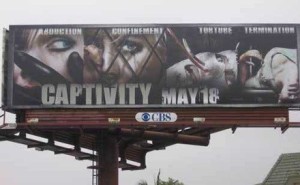Last week’s discussion on ‘ethical grey areas’ in advertising got me thinking. How does an ad that is so logically offensive to a majority of consumers get on the air in the first place? Could a bad ad be a ploy to bring attention to a brand? All publicity is good publicity, right?
Well as I said, this got me thinking, so I set out to research some high profile advertising flops to see just how a bad idea gets itself on camera.
1- Burger King disrespects Mexico.
In a 2009 advertising campaign, Burger King promoted its new “Texican Burger” (a burger they describe as a “spicy version of the whopper” (Business Pundit, 2011)) using a tall American cowboy and a “mini” Luchador wearing a Mexican flag around his neck (Associated Press, 2009). This proved disrespectful to the Mexican community and the Mexican flag.
Burger King’s response: That wasn’t their intent (Parekh, 2009). (They announced a revision of the ads.)
2- The Captivity film’s advertisements show no sympathy.
A film deemed a “Saw rip-off” posted billboards and taxicab ads across Los Angeles and New York that showcased graphic photos of a woman being tortured in captivity (Business Pundit, 2001). These ads were not only “gross” but with America reporting close to 850,000 kidnappings each year, they were insensitive (Business Pundit, 2011).
Film owners’ Lionsgate and After Dark Films response: It was an accident… and by the way, Captivity is more than a “Saw rip-off” (Gawker, 2007).
3- Australian KFC ad provokes racism claims in the U.S.
KFC produced an Australian commercial showing a white man at a cricket match surrounded by a group of “black West Indie supporters” (O’Malley, 2010). The ad read: Need a tip when you’re stuck in an awkward situation? While meant for the Australian market, this ad ignited cries of racism from offended Americans.
KFC’s response: The ad was meant for Australia and was illegally reproduced in the U.S (O’Malley, 2010). (KFC eventually apologized and pulled the ads.)
There are many more examples of shockingly bad ads, but these three highlight three possible themes of how bad ads happen to good people…
1- Accidental offensiveness: The creators of these ads really didn’t see anything wrong with them. (Hint: They were somehow able to overlook various sensitivities of large groups of people.)
2- Quality Control issues: Somehow these ads got released even though they were never supposed to be seen. (Hint: Someone got fired.)
3- Thinking a regional ad will stay regional: In a digital era with YouTube and smart phones, owners of these ads didn’t think they would go viral. (Spoiler alert: They did.)
References:
O’Malley, R. (January 7, 2010). KFC Australia pulls controversial ad. Retrieved January 31, 2016, from http://www.freerepublic.com/focus/f-news/2423302/posts
Business Pundit (May 12, 2011). 15 Controversial Pulled Ads – Business Pundit. (Retrieved January 31, 2016, from http://www.businesspundit.com/15-controversial-pulled-ads/
Parekh, R. (April 14, 2009). BK to Revise Ad After Complaints From Mexican Official. Retrieved January 31, 2016, from http://adage.com/article/global-news/burger-king-revise-ad-complaints-mexican-official/135989/
Gawker (March 19, 2007). Annals Of Ill-Conceived Outdoor Movie Advertising: The ‘Captivity’ Billboards. Retrieved January 31, 2016, from http://gawker.com/245382/annals-of-ill-conceived-outdoor-movie-advertising-the-captivity-billboards
Associated Press (April 14, 2009). Mexico says Burger King ad is ‘whopper’ of an insult. Retrieved January 31, 2016, from http://www.nydailynews.com/news/money/mexico-protests-europe-burger-king-texican-whopper-advertisement-mexican-flag-article-1.360441




7 Responses to When Bad Ads Happen to Good People